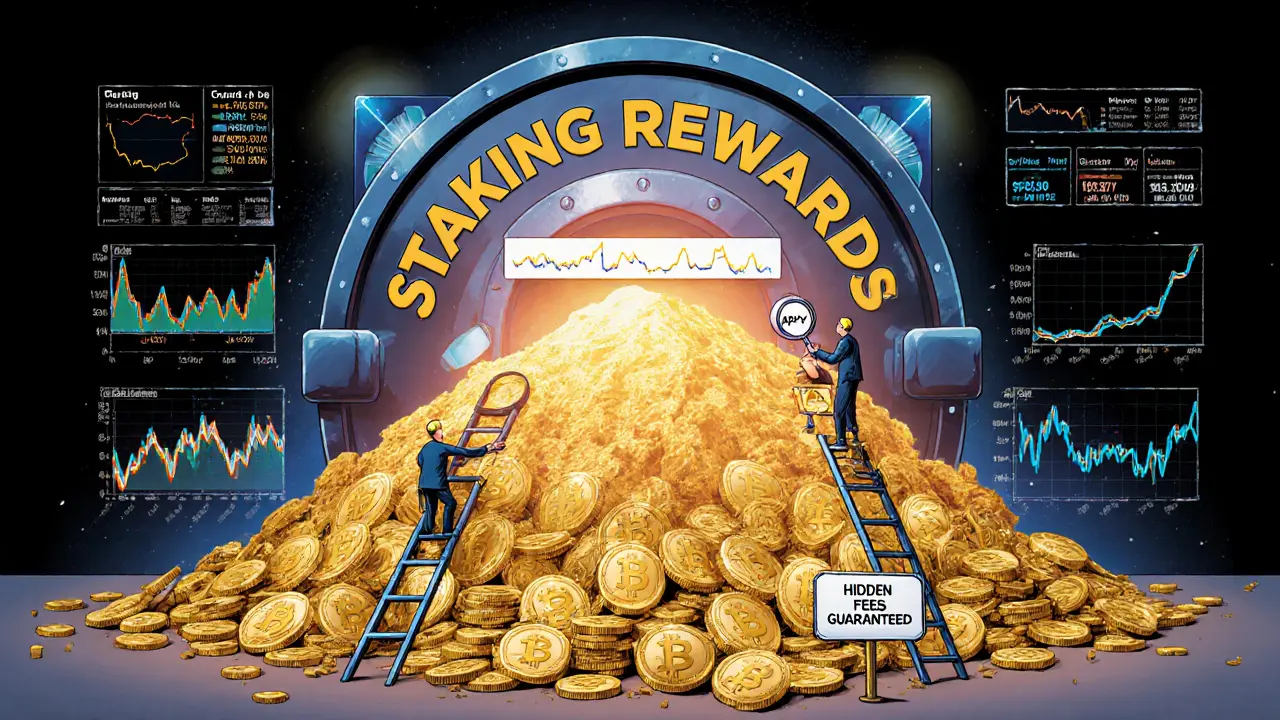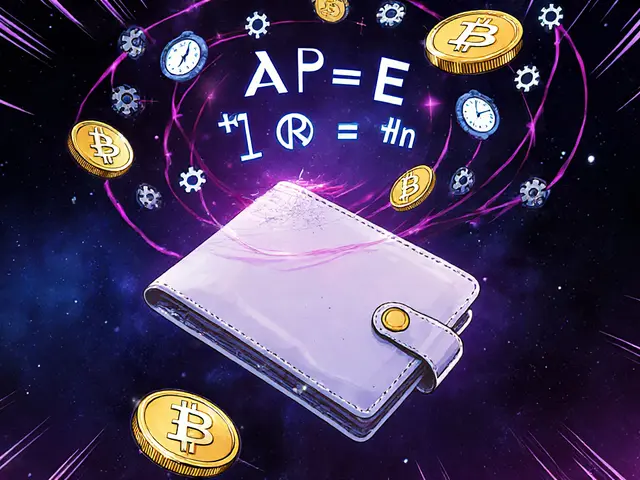Staking Rewards Calculator
APY vs APR: APR is simple interest on your original stake. APY includes compounding - your rewards earn rewards.
Example: $1,000 at 5% APR = $50 after 1 year. $1,000 at 5% APY (daily compounding) = $51.27.
Key Insight: The more frequently rewards compound (daily > monthly > quarterly), the higher your actual APY will be.
Important: This calculator shows estimated rewards based on current conditions. Actual APY may change due to network dynamics, token price fluctuations, and platform changes.
Your Estimated Staking Rewards
APY Calculation
Based on your inputsAPY: 0.00%
APR: 0.00%
Annual Rewards
Based on your inputsAnnual rewards: 0.00 units
Monthly rewards: 0.00 units
USD Value
Based on current token priceAnnual rewards: $0.00
Monthly rewards: $0.00
When you stake cryptocurrency, you’re not just locking up your coins-you’re earning more. But how much? That’s where APY comes in. It’s the number you see everywhere: 4.5% APY on Ethereum, 7% on Solana, 12% on some DeFi tokens. But what does that actually mean for your wallet? And why does it matter more than just looking at a flat interest rate?
APY vs APR: Why the Difference Matters
Many people confuse APY with APR. They look at a 5% rate and think, "That’s 5% a year. Easy." But if rewards are compounded, that 5% isn’t the whole story. That’s where APR and APY split apart. APR-Annual Percentage Rate-is simple interest. You stake $1,000 at 5% APR. After one year, you get $50. Done. No tricks. No extra earnings from your rewards. APY-Annual Percentage Yield-is different. It includes compounding. Every time you earn rewards, those rewards get added to your stake. Then they earn more. And more. And more. That’s the magic. If you stake $1,000 at 5% APY with daily compounding, you end up with $1,051.27 after a year. That’s $1.27 extra just because your rewards earned their own rewards. This isn’t theoretical. On Ethereum staking, if rewards are distributed every epoch (roughly every 6.4 minutes), your APY isn’t just a guess-it’s what your balance actually grows by, day after day. If you’re on a platform that auto-reinvests, you’re already getting APY, not APR.How to Calculate APY Yourself
You don’t need a calculator to understand how APY works. Here’s the formula:APY = [1 + (r ÷ n)]n - 1
- r = the nominal annual interest rate (like 0.05 for 5%)
- n = how many times rewards are compounded per year
Let’s say you’re staking a coin that pays 6% annually, compounded monthly. That’s 12 times a year.
APY = [1 + (0.06 ÷ 12)]12 - 1
APY = [1 + 0.005]12 - 1
APY = [1.005]12 - 1
APY ≈ 1.0617 - 1 = 0.0617 or 6.17%
So even though the platform says "6%," you’re really earning 6.17% because your rewards are compounding. That extra 0.17% might not sound like much-but on $10,000, it’s $17 extra per year. On $100,000? $170. Over five years? That’s over $900 in extra earnings just from compounding.
What Affects Staking APY Rates?
APY isn’t fixed. It changes. And it’s not just about the coin you pick. Three big things drive it:- Network factors: How many people are staking? How many coins are locked up? If everyone jumps in, rewards get split thinner. If fewer people stake, rewards go up. Ethereum’s APY dropped from 10%+ in 2022 to around 3.5% in 2025 because over 40% of all ETH is now staked.
- Validator performance: If you’re staking through a pool or exchange, their efficiency matters. Slashed validators (those who go offline or misbehave) reduce rewards for everyone in the pool. Some platforms take a cut too-5%, 10%, even 20%. That’s not in the APY you see.
- Platform policies: Some services promise "up to 15% APY" but only for the first month. Others lock your funds for 90 days and pay less. Always check the fine print.
That’s why you’ll sometimes see "Estimated APY" or "EAY" (Estimated Annual Yield). It’s not a guarantee. It’s a snapshot based on current conditions. A coin that pays 8% today might pay 5% next month if network demand changes.

Real-World Staking Examples
Let’s look at three real cases from October 2025:- Ethereum: Staking 3 ETH at 3.2% APY. ETH price: $1,811.16. Annual reward: 0.096 ETH ($173.87). Monthly: 0.008 ETH ($14.49).
- Solana: Staking 10 SOL at 6.8% APY. SOL price: $135. Annual reward: 0.68 SOL ($91.80). Monthly: 0.057 SOL ($7.65).
- DeFi token (e.g., AAVE): Staking 50 AAVE at 11.5% APY. AAVE price: $145. Annual reward: 5.75 AAVE ($833.75). Monthly: 0.48 AAVE ($69.48).
Notice something? The dollar value changes with the price. If ETH drops to $1,500, your $173 reward becomes $144-even if the APY stays the same. That’s why staking isn’t a "set and forget" income stream. You’re earning crypto, but its value moves.
Auto-Compounding: The Hidden Boost
Most DeFi staking platforms and exchanges now auto-compound. That means your rewards are automatically added to your stake every day, week, or even every block. No need to claim and restake manually. This is why APY is the only metric that matters here. If a platform says "5% APR," but compounds daily, they’re lying. They should say "5.12% APY." Always check how often compounding happens. Daily is best. Monthly is okay. Quarterly? You’re losing out.On a $5,000 stake:
- 5% APR (no compounding): $250 after a year
- 5% APY, daily compounding: $253.15
- 5% APY, monthly compounding: $252.60
That $3 difference might seem small. But over five years? You’re talking $150+ extra. And if you’re staking $50,000? That’s $1,500 more in your pocket.

Staking Calculators: Use Them, But Don’t Trust Them Blindly
There are dozens of crypto staking calculators online. They’re useful. But they’re only as good as the inputs.Most ask for:
- Amount staked
- APY
- Staking duration
- Token price
They spit out an estimate: "You’ll earn $890 in 12 months." Sounds great. But here’s the catch:
- What if the APY drops to 2% next month?
- What if the token price crashes 40%?
- What if the platform changes its compounding schedule?
Those calculators assume everything stays the same. It rarely does.
Use them to compare options, not to plan your retirement. If you’re staking for the long term, focus on reliability, not the highest APY. A 4% APY from a well-run, audited validator is better than a 12% APY from a sketchy DeFi pool that got hacked last year.
What to Watch Out For
Staking seems simple. But traps are everywhere:- Lock-up periods: Some platforms lock your coins for 21 days, 90 days, even 1 year. You can’t sell if the market crashes.
- Slashing risk: If you’re staking directly on a blockchain (not through an exchange), your validator can get slashed for downtime. That means losing part of your stake.
- Hidden fees: Some platforms advertise "9% APY" but charge 15% of your rewards. That’s not 9% anymore.
- Token volatility: Your rewards are paid in crypto. If the price drops, your dollar value drops-even if your coin balance goes up.
Always ask: "Is this APY sustainable?" If a coin offers 20% APY, it’s usually because the protocol is printing new tokens to pay you. That’s not wealth creation-it’s inflation. And it can’t last.
Final Rule: APY Is a Guide, Not a Guarantee
The best staking strategy isn’t chasing the highest APY. It’s choosing reliable networks, understanding how compounding works, and knowing your rewards are tied to real-world variables.Staking rewards are real. APY is the clearest way to compare them. But it’s not magic. It’s math. And math doesn’t lie-but the marketing around it often does.
Know the formula. Know the risks. Know your platform. Then stake with confidence.
What’s the difference between APY and APR in crypto staking?
APR is simple interest-it’s the rate you earn on your original stake only. APY includes compounding, meaning your rewards earn more rewards. For example, 5% APR on $1,000 gives you $50 after a year. 5% APY with daily compounding gives you $51.27. APY is always higher than APR when rewards are reinvested.
Is APY guaranteed in crypto staking?
No. APY is an estimate based on current network conditions. If more people start staking, rewards get diluted. If the network changes its reward rules, your APY drops. Some platforms label it "Estimated APY" or "EAY" to make this clear. Never assume your return is locked in.
How often should rewards be compounded for the best APY?
Daily compounding gives you the highest effective APY. Monthly is good. Quarterly or yearly is worse-you’re missing out on compounding growth. Always check your platform’s compounding frequency. If they don’t say, assume it’s monthly or worse.
Can I calculate my staking rewards in USD?
Yes. Multiply your staked amount by the APY to get your annual crypto reward, then multiply that by the current token price. For example: stake 10 ETH at 3.2% APY → earn 0.32 ETH/year. ETH price = $1,811 → $579.52 in USD. But remember: if ETH’s price drops, your USD value drops too.
Why do some platforms offer much higher APY than others?
High APY usually means one of two things: either the network is distributing new tokens to attract stakers (which can lead to inflation), or the platform is using risky DeFi strategies like lending or yield farming. These can collapse. Stick to established networks like Ethereum, Solana, or Cardano for more stable returns. Avoid anything over 10% unless you fully understand the risk.
Should I stake directly on the blockchain or through an exchange?
Exchanges make it easier-they handle the technical side and often auto-compound. But you don’t control your private keys. Staking directly gives you full control and usually better APY, but you’re responsible for validator uptime and security. For beginners, a trusted exchange like Coinbase or Kraken is safer. For experienced users, solo staking offers more control and potentially higher returns.



Wayne Overton
October 31 2025APY is just marketing fluff
Allison Andrews
November 1 2025It’s not fluff-it’s math. The difference between APR and APY matters because compounding isn’t theoretical. It’s how your money grows in real time, even if the extra $1.27 on $1,000 seems small. Over time, it adds up, and understanding that prevents you from being misled by platforms that advertise APR as APY.
Alisa Rosner
November 2 2025YES!!! 💯 Compounding is EVERYTHING. 🤯 I used to think 5% was 5%-until I learned daily vs monthly compounding. Now I only stake where it’s daily. Even $3 extra on $5k adds up. Don’t sleep on the little stuff-it’s the difference between "meh" and "I’m actually making money." 📈
MICHELLE SANTOYO
November 3 2025APY is a trap. Everything in crypto is designed to make you feel smart while they take your money. The math looks good but who controls the validator? Who prints the new tokens? The system’s rigged. You’re not earning yield-you’re funding a pyramid with blockchain glitter.
Lena Novikova
November 3 2025Stop overcomplicating this. If you don’t know what APY is you shouldn’t be staking. It’s not rocket science. Just check the compounding frequency and move on. Stop reading blogs and start staking. The math is right there in the docs. You don’t need a PhD to get 6%.
Olav Hans-Ols
November 5 2025Love this breakdown. Really clear and practical. I’ve been staking ETH for a year now and honestly didn’t realize how much daily compounding adds up until I ran the numbers. That extra $50 over five years on a $50k stake? That’s a weekend trip. Not bad for leaving it alone.
Kevin Johnston
November 5 2025Staking is the easiest passive income out there 💪 Just pick a solid chain, hit stake, and let it work. No need to overthink it. 🚀
Dr. Monica Ellis-Blied
November 6 2025It is imperative to emphasize that APY, while mathematically sound, is not a static or guaranteed metric. One must critically evaluate the underlying economic model of the protocol, assess the sustainability of token emissions, and verify the credibility of the validator infrastructure before committing capital. Failure to do so constitutes financial negligence.
Herbert Ruiz
November 6 2025Why are we even talking about this? Most people don’t understand APY and shouldn’t be staking. This post is for beginners. Go learn basics before posting.
Saurav Deshpande
November 8 2025APY is a central bank trick disguised as decentralization. The blockchain is just a ledger for the same inflationary system. They give you 12% to distract you from the fact that your coins are being diluted by new supply. The real wealth is in holding Bitcoin, not staking altcoins that vanish in a year.
Paul Lyman
November 10 2025Guys you’re overthinking this. I staked 10k on Solana and got paid every day. No math needed. Just pick a good platform. I use Kraken. They auto compound. Done. 💯
Frech Patz
November 10 2025Could you clarify the formula’s notation? Specifically, is the exponentiation in APY = [1 + (r ÷ n)]^n - 1 intended to be rendered as a superscript? The formatting appears ambiguous in the original text.
Derajanique Mckinney
November 11 2025APY? More like A-PY-unknowable 😅 I just pick the highest % and hope for the best. My wallet’s still up 😎
Rosanna Gulisano
November 12 2025Staking is gambling with your money. If you’re not rich you shouldn’t be doing this.
Sheetal Tolambe
November 12 2025This is so helpful! I just started staking last month and was confused about APR vs APY. Now I get it. I’m staking AAVE on a platform that compounds daily-so I’m actually getting 11.7% not 11.5%. Small difference but it feels good to know I’m not missing out.
jummy santh
November 13 2025As a Nigerian, I must say: this clarity is rare. In our markets, people chase 50% APY from unknown protocols and lose everything. You have explained with precision: APY is not a promise, it is a calculation. Thank you for grounding this in reality. In Lagos, we say: "No be magic, no be maths." And you have shown the maths.
Kirsten McCallum
November 14 2025Anyone who trusts APY is naive. The whole system is designed to extract value from the gullible. You think you’re earning? You’re just feeding the machine.
Henry Gómez Lascarro
November 16 2025Let’s be real: APY is a scam engineered by crypto influencers and exchange bots to lure retail investors into high-risk protocols that are either insolvent or already rug-pulled. The fact that you’re still calculating daily compounding means you haven’t noticed the real pattern: every high-APY token collapses within 18 months. Ethereum’s 3.2% is stable because it’s the only one left standing after the bloodbath. The rest? Ghosts in the blockchain.
Will Barnwell
November 17 2025This post is decent but ignores slashing risk. If you’re staking directly, your 6% APY could drop to 2% overnight because your validator went offline. Most people don’t even know what slashing is. That’s the real risk, not the math.
Lawrence rajini
November 18 2025Staking is the future 🌍 Just pick a good chain, let it ride, and watch your stack grow. No stress. No drama. Just crypto magic. 💫
Jean Manel
November 19 2025APY is a psychological weapon. The higher the number, the more people ignore the risks. You’re not investing-you’re speculating with borrowed confidence. And when the yield dries up, you’re left holding a worthless token and wondering why you didn’t just buy Bitcoin.